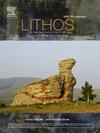P-T evolution and refined UPb geochronology of the giant eclogite layer of the Cabo Ortegal Complex (NW Iberian Massif)
IF 2.9
2区 地球科学
Q2 GEOCHEMISTRY & GEOPHYSICS
引用次数: 0
Abstract
In the Cabo Ortegal Complex (NW Iberian Massif), a 20 km long and 700 m thick layer of eclogites constitutes one of the world's largest outcrops of this type of rocks. It belongs to the Upper Allochthon, a terrane that represents the remnants of a Cambrian peri-Gondwanan fore-arc basin that was involved in the Variscan collision. In this layer, three types of eclogites are differentiated according to their mineralogy and bulk composition: the common, the ferrotitaniferous, and the Al-Mg-rich eclogites. This work studies the three types of eclogites via thermodynamic modelling. The ferric content of the bulk composition during the metamorphic peak is analyzed, the results demonstrating a strong influence on the metamorphic paragenesis in two of the three types. Isochemical equilibrium phase diagrams in the MnNCKFMASTHO system indicate metamorphic peak conditions of c. 23–25 kbar at c. 750–800 °C prior to a decompression up to c. 16–20 kbar. U![]() Pb dating in zircon crystals (LA-ICP-MS) from an eclogite yields an age of c. 390 Ma for the high-P metamorphism. All this indicates deep subduction of the peri-Gondwanan realm at the onset of the Variscan Orogeny during Early Devonian. The results are used to discuss the stacking of units that constitute the Upper Allochthon and envisage the processes that contributed to their exhumation.
Pb dating in zircon crystals (LA-ICP-MS) from an eclogite yields an age of c. 390 Ma for the high-P metamorphism. All this indicates deep subduction of the peri-Gondwanan realm at the onset of the Variscan Orogeny during Early Devonian. The results are used to discuss the stacking of units that constitute the Upper Allochthon and envisage the processes that contributed to their exhumation.
求助全文
约1分钟内获得全文
求助全文
来源期刊

Lithos
地学-地球化学与地球物理
CiteScore
6.80
自引率
11.40%
发文量
286
审稿时长
3.5 months
期刊介绍:
Lithos publishes original research papers on the petrology, geochemistry and petrogenesis of igneous and metamorphic rocks. Papers on mineralogy/mineral physics related to petrology and petrogenetic problems are also welcomed.
 求助内容:
求助内容: 应助结果提醒方式:
应助结果提醒方式:


